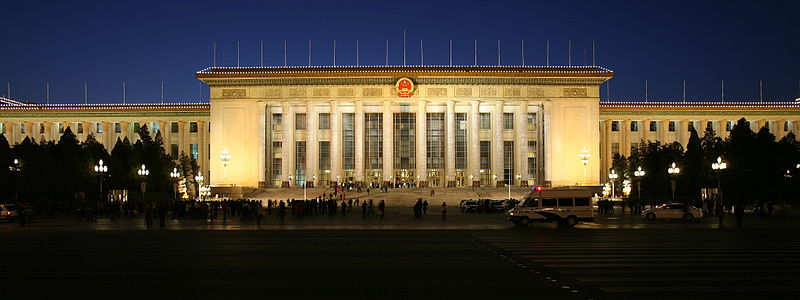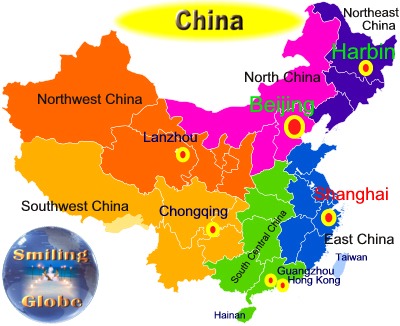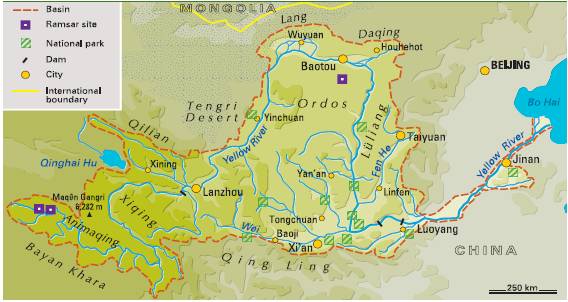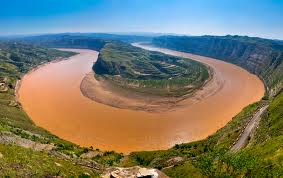Read more about
Chongqing Chongqing.
People´s Republic of China
 |
| Great Hall Of The People Beijing China |
China, officially the People´s Republic of China, is a sovereign state located in
East Asia.
China is the world´s most populous country, with a population of over 1.35 billion.
The PRC is a single-party state governed by the Communist Party, with its
seat of government in the capital city of Beijing.
The PRC exercises jurisdiction over 22 provinces, five autonomous regions,
four direct-controlled municipalities (Beijing,
Tianjin
Shanghai, and
Chongqing), and two mostly self-governing special administrative regions (Hong
Kong and Macau).
The PRC also claims Taiwan – which is controlled by the Republic of
China (ROC), a separate political entity – as its 23rd province, a claim which
is controversial due to the complex political status of Taiwan. Covering
approximately 9.6 million square kilometers, China is the world´s
second-largest country by land area, and either the third or fourth-largest by
total area, depending on the method of measurement. China´s landscape is vast
and diverse, ranging from forest steppes and the Gobi and Taklamakan deserts in
the arid north to subtropical forests in the south.
China Regions
This is the 31 provincial-level divisions of the People´s Republic of China grouped by its former administrative areas from 1949 to 1952, which are now known as six traditional regions.
| Region |
Area |
Population |
Density |
| East China
|
795,837 km² |
384,364,968 |
483/km² |

|
Provinces: Shanghai
Anhui
Fujian
Jiangsu
Jiangxi
Shandong
Zhejiang
|
| North China |
1,556,061 km² |
164,823,226 |
105/km² |
Provinces: Beijing
Henan
Hebei
Shanxi
Tianjin
|
| Northeast China |
793,300 km² |
109,520,844 |
138/km² |
Provinces: Heilongjiang
|
| Northwest China |
3,107,701 km² |
96,644,038 |
60/km² |
Provinces: Gansu
Qinghai
Shaanxi
Ningxia Xinjiang
|
| South Central China |
1,014,354 km² |
383,559,808 |
378/km² |
Provinces: Guangdong
Hainan Henan
Hubei Hunan
Guangxi
Hong Kong
Macau
|
| Southwest China |
2,365,900 km² |
192,979,243 |
82/km² |
Provinces:
Chongqing Guizhou
Sichuan Yunnan
|
|
 |
| The Yangtze and Yellow Rivers |
The Himalaya, Karakoram, Pamir and Tian Shan mountain ranges separate China from South and Central Asia.
The Yangtze and Yellow Rivers, the third- and sixth-longest in the world, run from the Tibetan Plateau to the densely populated eastern seaboard. China´s coastline along the Pacific Ocean is 14,500 kilometres (9,000 mi) long, and is bounded by the Bohai, Yellow, East and South China Seas.
 |
| The Yellow Rivers Northern China |
The history of China goes back to the ancient civilization – one of the world´s earliest – that flourished in the fertile basin of the Yellow River in the North China Plain.
For millennia, China´s political system was based on hereditary monarchies, known as dynasties, beginning with the semi-mythological Xia of the Yellow River basin
. Since 221 BCE, when the Qin Dynasty
first conquered several states to form a Chinese empire, the country has expanded, fractured and been reformed numerous times.
The Republic of China (ROC) overthrew the last dynasty in 1911, and ruled the Chinese mainland until 1949. After the defeat of the Empire of Japan in World War II, the Communist Party defeated the nationalist Kuomintang in mainland China and established the People´s Republic of China in Beijing on 1 October 1949, while the Kuomintang relocated the ROC government to its present capital of Taipei.
Since the introduction of economic reforms in 1978, China has become one of the world´s fastest-growing major economies. As of 2013, it is the world´s second-largest economy by both nominal total GDP and purchasing power parity (PPP), and is also the world´s largest exporter and importer of goods. China is a recognized nuclear weapons state and has the world´s largest standing army, with the second-largest defense budget.
The PRC has been a United Nations member since 1971, when it replaced the ROC as a permanent member of the U.N. Security Council. China is also a member of numerous formal and informal multilateral organizations, including the WTO, APEC, BRICS, the Shanghai Cooperation Organisation, the BCIM and the G-20. China is a regional power within Asia and has been characterized as a potential superpower by a number of commentators.
 |
| Chinese wedding culture |
The Chinese wedding culture in modern and contemporary times has been
undergone constant evolvements and innovations, presenting the characteristics
of a rich combination of western and eastern cultures and both traditions and
fashions.
Read more about Chinese
Culture
Anhui is a province of the People's Republic of China, and is part of the
East China
region. Anhui is located across the basins of the Yangtze River and the Huai River, and borders
Jiangsu to the east,
Zhejiang to the southeast,
Jiangxi to the south,
Hubei to the southwest,
Henan to the northwest, and
Shandong for a tiny section in the north.
Anhui is Covering an area of 139,600 square kilometers (about 53,900 square
miles) and is a Major Economic and Technological Development Zones with a total population of 60,300,000 (2013)
Inhabitants.
See ratings  af Southwest China , Do you have rice or praise for this Bed and Breakfast, Write your review
af Southwest China , Do you have rice or praise for this Bed and Breakfast, Write your review 